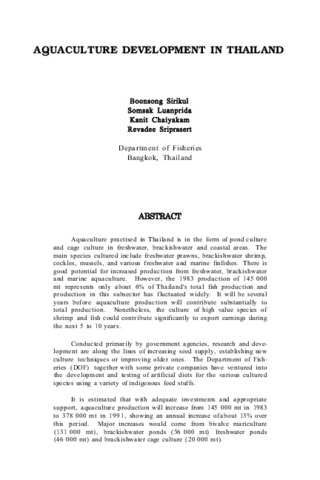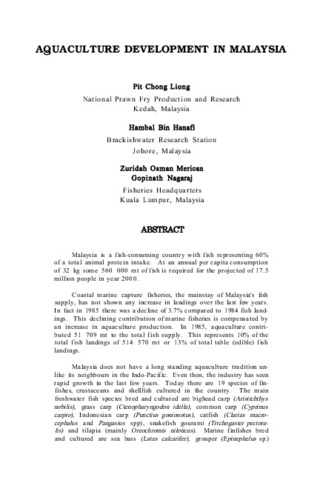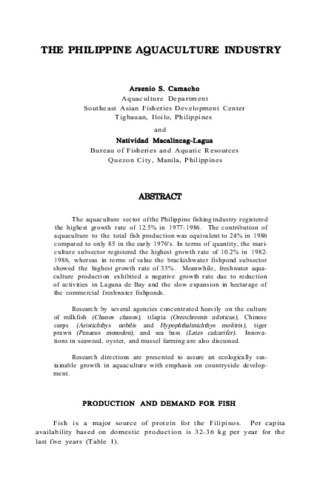Cambodia: Status of implementation of the resolution and plan of action on aquaculture.
Share
| dc.contributor.author | Da, Chin | |
| dc.contributor.editor | Acosta, Belen O. | |
| dc.contributor.editor | Coloso, Relicardo M. | |
| dc.contributor.editor | de Jesus-Ayson, Evelyn Grace T. | |
| dc.contributor.editor | Toledo, Joebert D. | |
| dc.date.accessioned | 2013-12-05T14:12:14Z | |
| dc.date.available | 2013-12-05T14:12:14Z | |
| dc.date.issued | 2011 | |
| dc.identifier.citation | Da, C. (2011). Cambodia: Status of implementation of the resolution and plan of action on aquaculture. In B. O. Acosta, R. M. Coloso, E. G. T. de Jesus-Ayson, & J. D. Toledo (Eds.), Sustainable aquaculture development for food security in Southeast Asia towards 2020. Proceedings of the Regional Technical Consultation on Sustainable Aquaculture Development in Southeast Asia Towards 2020 (pp. 67-71). Tigbauan, Iloilo, Philippines: SEAFDEC Aquaculture Department. | en |
| dc.identifier.isbn | 9789718511992 | |
| dc.identifier.uri | http://hdl.handle.net/10862/1825 | |
| dc.description.abstract | The country s current national development plan (National Strategic Development Plan - NSDP) for 2006-2010 gives priority to addressing poverty alleviation and improving food security particularly of the rural farmers. In line with the NSDP s goal which is to ensure sustainable access to fisheries resources by the poor, the Fisheries Administration (FiA) of the Ministry of Agriculture, Forestry and Fisheries has drafted the Strategic planning framework for fisheries: 2009-2018, which considers small-scale aquaculture as one of the most important approaches. Based on the NSDP, FiA will focus on aquaculture development and aquatic resources management for poverty reduction of the rural families in the entire country as well as the medium and large scale aquaculture development. The family aquaculture plays an important role in securing the animal protein requirement and generating cash income in the rural areas of Cambodia. On the other hand, the medium and large scale aquaculture are targeted to provide opportunities for the export market since Cambodia has a lot of potential for developing large scale aquaculture production. FiA has strongly considered the strategies of NSDP important particularly in the present time when the population is increasing and the country cannot meet the fish protein requirements capture fisheries alone. | en |
| dc.language.iso | en | en |
| dc.publisher | Aquaculture Department, Southeast Asian Fisheries Development Center | en |
| dc.subject | Cambodia | en |
| dc.title | Cambodia: Status of implementation of the resolution and plan of action on aquaculture. | en |
| dc.type | Conference paper | en |
| dc.citation.spage | 67 | |
| dc.citation.epage | 71 | |
| dc.subject.asfa | aquaculture | en |
| dc.subject.asfa | aquaculture development | en |
| dc.subject.asfa | aquaculture economics | en |
| dc.subject.asfa | breeding | en |
| dc.subject.asfa | cage culture | en |
| dc.subject.asfa | culture effects | en |
| dc.subject.asfa | feeds | en |
| dc.subject.asfa | fish culture | en |
| dc.subject.asfa | fish diseases | en |
| dc.subject.asfa | Fish meal | en |
| dc.subject.asfa | food security | en |
| dc.subject.asfa | livelihoods | en |
| dc.subject.asfa | national planning | en |
| dc.subject.asfa | pond culture | en |
| dc.subject.asfa | seed (aquaculture) | en |
| dc.subject.asfa | Small scale aquaculture | en |
| dc.subject.asfa | sustainability | en |
| dc.citation.conferenceTitle | Sustainable aquaculture development for food security in Southeast Asia towards 2020. Proceedings of the Regional Technical Consultation on Sustainable Aquaculture Development in Southeast Asia Towards 2020 | en |
Files in this item
| Files | Size | Format | View |
|---|



